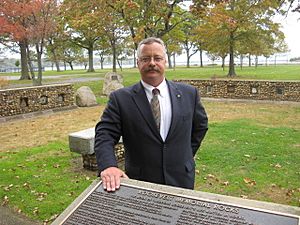Theodore Roosevelt Memorial Park facts for kids
Theodore Roosevelt Memorial Park is a special place in Oyster Bay, New York. It honors Theodore Roosevelt, who was the 26th President of the United States. This park is a beautiful spot for everyone to enjoy by the water.
Contents
How the Park Began
This park wasn't always a nice place. Long ago, the land was a messy, marshy area. It was even used as a dumping ground. Old shacks dotted the landscape, making it look quite untidy.
For hundreds of years, cows grazed in this salty marsh. But by the late 1800s, people without homes started living there. They built small shacks on the land.
When people arrived at the new Oyster Bay Railroad Station, they saw all this trash and these rundown shacks. One frequent traveler was Theodore Roosevelt. He often took the train when he was the head of the New York City Police.
Even then, Roosevelt wished for a "breathing place" for everyone in Oyster Bay. He especially wanted it for those who were less fortunate. He didn't know then that this very spot would become a park named after him.
Creating a Memorial
After President Roosevelt passed away on January 6, 1919, people wanted to honor him. Just days later, on January 10, 1919, a group called the "Roosevelt Permanent Memorial National Committee" was formed.
This committee met again in New York City on March 24, 1919. They created the Roosevelt Memorial Association. This group was officially recognized by Congress on May 31, 1920. Its goal was to "perpetuate the memory of Theodore Roosevelt." This meant keeping his memory alive for people in the United States and around the world.
The Roosevelt Memorial Association had three main goals. First, they wanted to build a big memorial for TR in Washington, D.C. Second, they planned to create a public park in Oyster Bay, New York. Third, they aimed to raise money to keep Roosevelt's ideas alive.
The idea of a public park in Oyster Bay helped bring together local groups. These groups also wanted to honor Roosevelt. Buying the land for the park took many years. The Townsend family quickly sold their land for a fair price.
However, another large section of land was much harder to get. Suddenly, the "worthless" marsh became very valuable. While they tried to reach an agreement with the landowner, the Town decided to use the area as its official dump.
They thought it made sense. They needed to fill in the marshy land anyway. And the town's garbage had to go somewhere. In 1925, a judge finally settled the legal issues. The Town could then buy the rest of the parkland.
From Dump to Park
After buying the land, the big job of transforming it began. The old shacks were removed. The Oyster Bay Lumber Company, which operated there, moved to a new location.
Workers then started the huge task of making the shoreline straight. They also leveled the land and built a strong seawall.
Finally, in May 1928, the new Theodore Roosevelt Memorial Park was ready. A dedication ceremony was held with over 5,000 people attending. There was a parade and even planes flying overhead. The planes dropped bouquets of flowers into the water.
Later, in 1942, the Theodore Roosevelt Association gave the park to the Town of Oyster Bay.
What You'll Find in the Park
The park was first designed with paths running east-west and north-south. The west side of the park is used for active fun. Today, it has tennis courts, a softball field, and a children's play area. There's also a large parking lot there.
The east side has paths that spread out like spokes from a wheel. These paths lead from the park entrance on Railroad Avenue north to the water. A large flagpole stands in a plaza area there. This part of the park is for quiet activities and remembering Roosevelt.
Memorials and Features
You'll find several memorials in the park. At the park entrance, there's a stone with a plaque honoring TR. There's also a Theodore Roosevelt Monument Assemblage. This monument includes stones and items from important times in Roosevelt's life. It highlights his service to New York City, New York State, the United States, and the world.
Next to this monument is a fountain. Water flows in two directions from a raised, rectangular sculpture.
Just east of these memorials is a marina for boats. South of the marina and near the railroad tracks, you'll find a parking lot. There's also a picnic area with several covered pavilions.
See also


